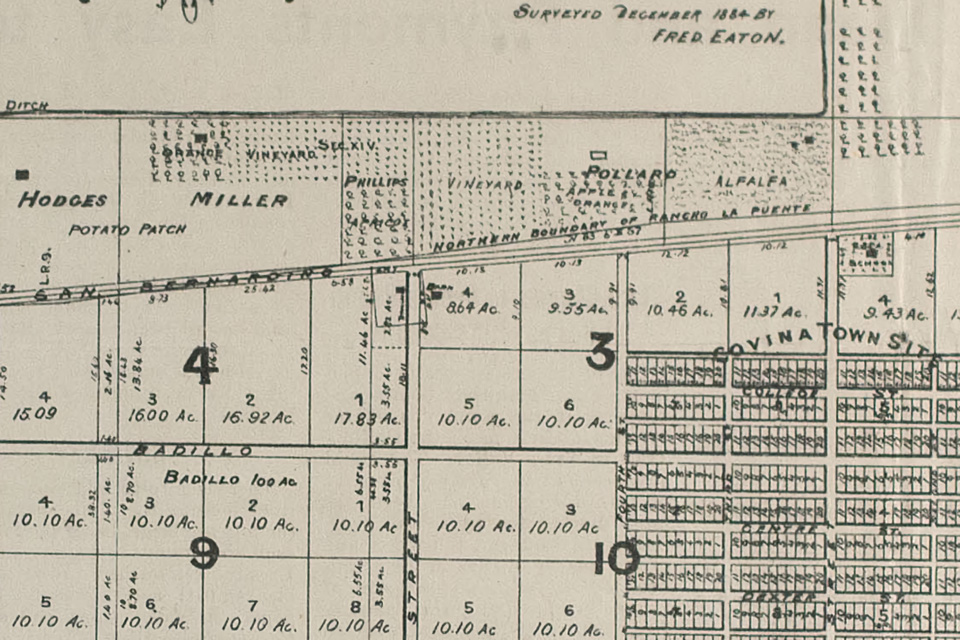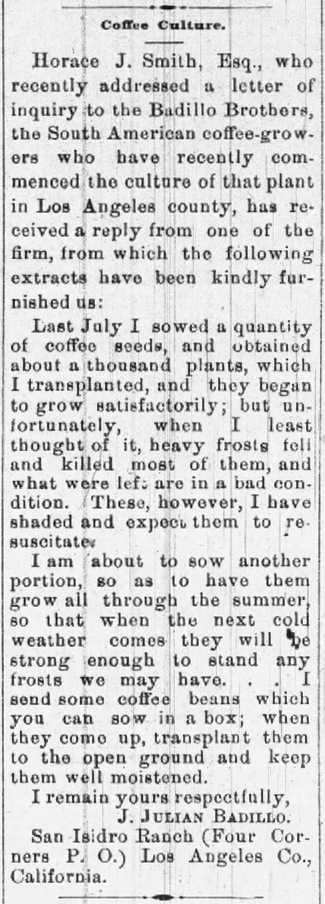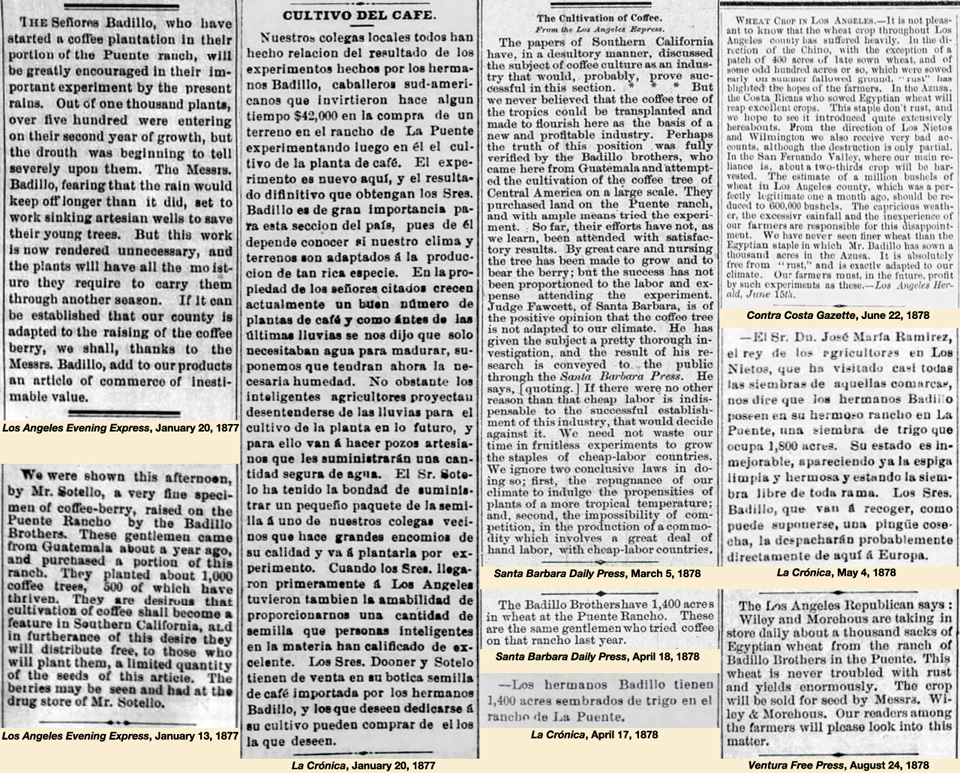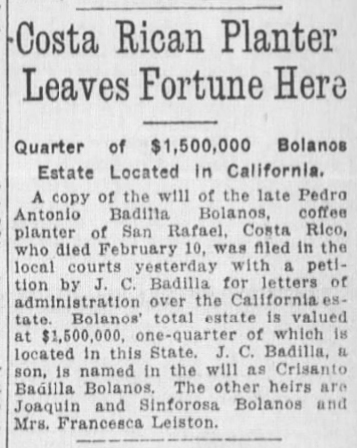There's been all kinds of speculation in recent years about the name of Badillo Street in Covina and why it differs from the pioneer family's hereditary Spanish name, Badilla.

Covina's main east/west street was named "Badillo" on the original Phillips Tract survey map in 1884.
Courtesy Covina Valley Historical Society.
I briefly mentioned my own ideas about this controversy at the end of the article about Hollenbeck and the Badillas that I posted back in 2021. I noted that the family themselves appeared to use a terminal –o in their surname on occasion, and theorized that the street was named "Badillo" because that was the name the farming brothers were best known by.
I didn't have direct evidence for either claim until just yesterday, though, when I found this letter published in a newspaper in 18771 that was signed, "J. Julian Badillo." This was the first time I'd seen one of the famous coffee-growing brothers apparently using the Badillo spelling himself (and the first I've seen the name of their coffee plantation was "San Isidro Ranch.")

Santa Barbara Daily Press, February 7, 1877.
With that revelation, I then thought about examining the idea of name familiarity, so I did more specific searches on the newspaper archive website to manually tally the number of times the two surname spellings were used, and in which contexts they appeared.
• Total number of unique newspaper mentions of the family as Badilla between 1876-1879: 29
Contexts: Travel, 1; Post office, 13; Legal matters, 13; Agriculture, 2.
• Total number of unique newspaper mentions of the family as Badillo between 1876-1879: 44
Contexts: Travel: 2, Post office, 9; Legal matters, 2; Agriculture, 31.
When a mention concerned legalities—like a land purchase or sale, lawsuit, or other matters of official record—their name was almost always given as Badilla. However, when a newspaper wrote specifically about the family's agricultural enterprises, the –o spelling occurred in print 15x more often than –a, and all 22 of the mentions related to coffee-growing used the name Badillo.2

Widely publicized in California, almost all newspaper reports of the family's agricultural ventures used the "Badillo" spelling, even in Spanish.2
Clippings © Newspapers.com.
One wonders why the farming brothers might have chosen to use what we'd now call a trade name instead of their real name, but robustly non-random data like a 31-2 occurrence of one spelling versus the other in publicity about agriculture (and 100% in reference to coffee) does give me sufficient confidence to reject the hypothesis that "Badillo" was simply the chance outcome of mistaking one vowel for another.
In summary, Badilla was indeed the family's true and legal name, but my conclusion based on this analysis is that Badillo was the trade name they used in the ag business—specifically with regard to their coffee enterprise—and as a result of statewide publicity, the latter became the name they were best known by. Admittedly this is still speculative, but at least it's a simple explanation that accounts for all the known facts and has actual numbers backing it up.
Now, about that street name. It's often overlooked that, from 1882-1885, Antonio Badilla and Covina founder J. S. Phillps lived less than a hundred yards from one another on San Bernardino Road.3 They doubtless spoke frequently during their many years as next-door neighbors, and when Phillips' new tract was surveyed and subdivided, surely he would have told Antonio that he intended to name a street after him. Additionally, because Phillips himself knew that the family went by both Badilla and Badillo at times,4 he would have asked his neighbor which spelling he preferred.
The scenario above is admittedly conjectural, but isn't it also logical? And consider—even if those two gentlemen didn't know each other personally—if you were a city father, and you wanted to name something in your town after someone, wouldn't you use the name most people recognized, even if it was an alias? Everyone in the community at the time knew the Badillos were the famed coffee growers, so it only makes sense that would be the name chosen to honor and memorialize them.

Although we now have some plausible answers to the "Badillo" question, other Badilla family mysteries will likely remain unsolved. Primarily, I'm still unsure about the exact nature of the relationship between J. Edward Hollenbeck and the Badillas, and why it soured so completely in such a relatively short period of time. In 1879, the indebted eldest brothers José Julián and Pbro. Pedro Maria lost their land in Hollenbeck's foreclosure action. Both departed California never to return, and spent the rest of their lives in Arizona Territory.5
Less has been said about what happened to younger brother Pedro Antonio. Although he had been a working partner in the coffee venture, it is now known that Antonio was not involved with the debt or foreclosure that ruined his brothers.5 Quite the contrary, Hollenbeck evidently held Antonio in such high regard that he gave him 100 acres of the former Badilla lands for free:3,5 a kindness that allowed Antonio's family to keep their home and farmstead. (Yet another Badilla mystery that intrigues me!)

Hollenbeck's 1881 deed named "Antonio Badillo" as grantee.
In February, 1886, Antonio Badilla sold his Covina property to Daniel Houser for $12,000.6 He then returned to Costa Rica and resumed growing coffee.7 That's all the history books have said about him until now. Remarkably, I was surprised to discover only recently that, in the remaining years of his life, Antonio Badilla became a fabulously wealthy man.8

San Francisco Examiner, July 10, 1913.
As you can see in the clipping above, at the time of his death in 1913, Antonio Badilla's multinational estate was valued at $1,500,000: a sum that this inflation calculator says is equal to $48 million today. If true, I think it's pretty safe to say that, after he left Covina, Pedro Antonio Badilla Bolaños went on to become one of the richest men in Central America. That's some happy ending!

References:
1 Santa Barbara Daily Press, February 7, 1877, p.2. (also Los Angeles Evening Express, February 10, 1877, p.3.)
2 My detailed Badilla/Badillo newspaper search results can be viewed by clicking here.
3 Pflueger, D. H. 1964. Covina: Sunflowers, Citrus, Subdivisions. Castle Press, Pasadena, California, 372pp.
4 "Badillo – Badilla – or Eaton," by Glenn Reed. Originally published in The Covina Citrus Peal, Covina Valley Historical Society, October, 2016.
5 "Hollenbeck and the Badillas," Covina Past weblog, September 7, 2021.
6 Los Angeles Times, February 3, 1886, p.3.
7 Covina Argus, May 4, 1912, p.20.
8 San Francisco Examiner, July 10, 1913, p.3.
2 comments:
Thanks for the information on the Badillo/Badilla question. I've wanted to know for years if it was a typo or deliberate.
I grew up in Covina from 1965 through 1979 and remember it well. I still have relatives in the Valley and the Inland Empire.
Over the time I've been reading your incredible blog, I've seen you occasionally comment about weather it was worth the effort given what is apparently a smaller audience than you wish. I'm just here to say that I think your work is remarkable and that I deeply appreciate every single post. With gratitude
Post a Comment
To post a comment, you must login to this page with the Google Chrome web browser. That is the only way that works now.